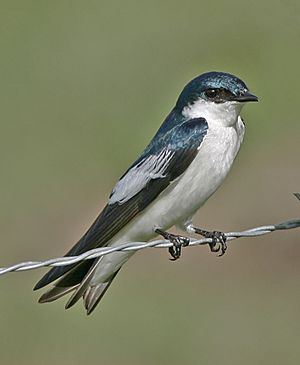White-winged swallow facts for kids
Quick facts for kids White-winged swallow |
|
|---|---|
 |
|
| at rest in the Llanos, Venezuela | |
| Conservation status | |
| Scientific classification | |
| Genus: |
Tachycineta
|
| Species: |
albiventer
|
 |
|
The white-winged swallow (Tachycineta albiventer) is a beautiful bird found in warm parts of South America. You can spot them in countries like Colombia, Venezuela, and Argentina. Unlike many birds, they usually stay in one place and don't travel far. These swallows are not found west of the Andes mountains.
Contents
Discovering the White-winged Swallow
The white-winged swallow got its scientific name, Hirundo albiventer, in 1783 from a Dutch scientist named Pieter Boddaert. This bird was first described by a French scientist, Georges-Louis Leclerc, Comte de Buffon, in 1780. He wrote about it in his book Histoire Naturelle des Oiseaux. The name Tachycineta comes from an old Greek word meaning "moving quickly." The word albiventer is Latin and means "white belly," which describes this bird perfectly!
What Does a White-winged Swallow Look Like?
The adult white-winged swallow is about 14 cm (5.5 in) long, which is about the length of your hand. It weighs between 14–17 g (0.49–0.60 oz), which is very light!
- Feathers: Its back and head are a shiny blue-green color. Its belly and the area above its tail are white.
- Wings: The wings are mostly black, but they have cool white edges on some of the feathers.
- Eyes and Beak: It has dark brown eyes and a black beak and legs.
Boy and girl swallows look very similar. However, the females might have a little less white on their wings. Young swallows are a bit duller in color and have grayer bellies than the adults. They also have less white on their wings.
You can tell a white-winged swallow apart from a similar bird called the mangrove swallow. The white-winged swallow does not have a white line above its eyes. It also has more white on its wings.
What Sounds Do They Make?
The white-winged swallow makes a harsh chirrup sound. It can also make a repeated, buzzing sound that goes up in pitch, like zweeed. If they sense danger, they make a short, harsh alarm call.
Where Do White-winged Swallows Live?
White-winged swallows live in many countries in South America. These include Argentina, Bolivia, Brazil, Colombia, Ecuador, French Guiana, Guyana, Paraguay, Peru, Suriname, Trinidad and Tobago, and Venezuela. Sometimes, a few might even fly as far as Panama! They usually stay away from the Pacific coast, especially in the southern parts of South America.
These birds love to be near water. You will often find them in low-lying areas along rivers or lakes. They usually live at elevations of about 500 m (1,600 ft) (about 1,640 feet).
Most white-winged swallows stay in the same area all year. However, those living in the southernmost parts of their range do migrate. In Brazil and Argentina, they are only present from about mid-September to mid-April. We don't know exactly where these birds go for winter, but it's probably to countries like Guyana, Venezuela, and Colombia.
White-winged Swallow Life and Habits
Reproduction and Nests
White-winged swallows build their nests in safe, hidden spots. They like to use holes in trees or spaces between large rocks. Sometimes, they even build nests in structures made by people. Their nests are shaped like a cup and are lined with soft feathers from other birds and some seeds.
They usually build their nests a few meters (several feet) above water. Each pair of swallows builds its own nest. A mother swallow will lay three to six white eggs. Each egg is about 17 mm–20 mm × 13 mm–14.6 mm (0.67 in–0.79 in × 0.51 in–0.57 in) in size and weighs about 1.9 g (0.067 oz).
What Do White-winged Swallows Eat?
White-winged swallows are great at catching flying insects! They mostly hunt while flying low, often over water. They can also find food over land. When they are not hunting, they like to rest on branches near water. They fly in a direct path, flapping their wings steadily.
Protecting the White-winged Swallow
The white-winged swallow is doing well! Scientists classify it as a Least Concern species. This means that its population is large and stable, and it lives in a very wide area. So, there is no immediate worry about this species disappearing.
Images for kids




